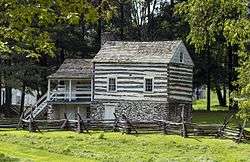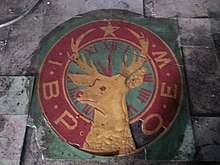Kennedy Farm
|
Kennedy Farm | |
 The restored Kennedy Farm House in 2016 | |
  | |
| Location | Samples Manor, Maryland |
|---|---|
| Coordinates | 39°22′47″N 77°42′56″W / 39.37972°N 77.71556°WCoordinates: 39°22′47″N 77°42′56″W / 39.37972°N 77.71556°W |
| Area | 1.77 acres (0.72 ha) |
| Built | circa 1800; 1852 |
| NRHP reference # | 73000941 |
| Significant dates | |
| Added to NRHP | November 7, 1973[1] |
| Designated NHL | November 7, 1973[2] |

The Kennedy Farm is a National Historic Landmark property on Chestnut Grove Road in rural southern Washington County, Maryland. It is notable as the place where the radical abolitionist John Brown planned and began his raid on Harpers Ferry, West Virginia in 1859. Also known as John Brown's Headquarters and Kennedy Farmhouse, the log, stone and brick building has been restored to its appearance at the time of the raid. The farm is now owned by a preservation nonprofit, and the grounds surrounding the building are open to the public.[3]
Historic significance
The Kennedy Farm is a parcel of under 2 acres (0.81 ha) of land on the west side of Chestnut Grove Road, a few miles north of Harpers Ferry, West Virginia in a rural part of southern Washington County, Maryland. It is part of a much larger farm property that was purchased in 1852 by Dr. Robert Kennedy. Kennedy took the small log cabin on the property, and mounted it on a tall (one-story in height) stone foundation, added a frame addition to one side, and covered both with a gabled roof. Kennedy died in 1858.[4]
Brown arrived in Maryland in 1859 and rented the house. For three months Brown and his co-conspirators lived here, planning an attack on the federal armory at Harpers Ferry in a bid to incite a slave rebellion. During that time he assembled his group of family members and followers, as well as a small arsenal of weapons. The raid, which began October 16, 1859, was an abject failure in achieving Brown's objective. Some of his band were killed, and Brown himself was arrested, tried, convicted, and hanged for the action. However, the raid had the effect of hardening and galvanizing pro and anti-slavery positions in the United States prior to the outbreak of the American Civil War.[5]
Post-raid history
.jpg)
The house underwent a number of ownership changes, and significant alterations, over the next 100+ years. In 1950, the IBPOEW (Black Elks) purchased the property as a memorial to John Brown and operated it as their National Shrine. During the years leading up to their selling of the property in 1966, the Elks built several buildings on the then-235 acre property, including a 50' by 124' auditorium that was used as a meeting place for Elks gatherings of up to three thousand persons on Fourth of July and Labor Day weekends.
The auditorium (visible in the top photo behind the trees to the left of the farmhouse) was rented on summer weekends by a local black entrepreneur, John Bishop, who booked into that venue dozens of the biggest stars of rhythm and blues on the Chitlin' Circuit, including Ray Charles, Aretha Franklin, James Brown, Marvin Gaye, Little Richard, Chuck Berry, B. B. King, Eartha Kitt, Otis Redding, Etta James, the Coasters, and the Drifters.[6]
When it was designated a National Historic Landmark in 1974, it was described as a 2 1⁄2-story house that used stone, brick and log construction with a stucco overlay. It had four bays, with a double-tiered porch running outside three rooms on the first and second floors. There were two rooms in the attic, and a small shed addition to the rear. An interior stair links the central rooms inside, and an exterior stair links the porch's two levels.[5]
The house then underwent a major restoration effort, funded by public and private sources, to return it to its 1850s appearance.[4]
See also
References
- ↑ National Park Service (2008-04-15). "National Register Information System". National Register of Historic Places. National Park Service.
- ↑ "Kennedy Farm". National Historic Landmark summary listing. National Park Service. Archived from the original on 2007-11-14. Retrieved 2008-06-17.
- ↑ "The Kennedy Farmhouse". The Kennedy Farmhouse. Retrieved 2017-03-31.
- 1 2 "Restoration". The Kennedy Farmhouse. Retrieved 2017-03-31.
- 1 2 Levy, Benjamin (June 13, 1973). "National Register of Historic Places Inventory Nomination: Kennedy Farm". National Park Service. Retrieved 2009-03-24.
- ↑ <Maliskas, Ed. John Brown to James Brown - The Little Farm Where Liberty Budded, Blossomed, and Boogied, Hagerstown, MD: Hamilton Run Press, 2016>
External links
| Wikimedia Commons has media related to Kennedy Farm. |
- Official website
- John Brown's Headquarters, Washington County, including photo in 1976, at Maryland Historical Trust
- Historic American Buildings Survey (HABS) No. MD-227, "Kennedy Farm, Chestnut Grove Road, Samples Manor vicinity, Washington County, MD", 12 photos, 8 measured drawings, 4 data pages, 1 photo caption page

